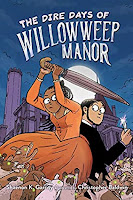

It's
Marvelous Middle Grade Monday
at
and #IMWAYR day
at
and
Baptiste, Tracey.
African Icons: Ten People Who Shaped HistoryOctober 19th 2021 by Algonquin Young Readers
ARC provided by Young Adult Books Central
In her introduction to this book, Ms. Baptiste mentions that every February, for Black History Month, her children would bring home a single sheet of paper about Black history, that usually doesn't even venture outside of the US. Given the impressive range of African history, this is quite a gap in the education about this continent.
This book helps, although we still need many more books like it. In a fashion similar to collective biographies about kings and queens of England, we are introduced to ten historical figures, ranging from rulers to writers to military leaders. Some, about whom little is known, may be new to readers (such as Menses and Meneith, Egyptian rulers, and Mansa Musa, the richest man of all time), and others (like Imhotep, Hannibal Barca, Terence, and Aesop) offer additional, thought provoking information about well known figures. Each short biography is accompanied by a beautiful illustration by Wilson, bordered in pages decorations based on extant artwork from that person's culture.
In between these chapters are helpful descriptions of some of the societal constructs, historic framework, or rarely covered facts. These chapters cover topics such as the use of metal in the ancient world, how nature helped inform African stories, and how other powers invaded the continent and enslaved its inhabitants. These chapters help readers understand some of the things that happen to the biographical figures or what their world would have looked like.
There are plenty of interesting facts to tuck away for future reference. I found the chapter on Aesop, particularly, to be fascinating and informative. The Greeks had many writers and educators who were enslaved, but their histories are often not addressed. I thought it was interesting that Terrence, for example, is so much better known than Ennius!
Because there are so few books on African history, this could have easily been a whole series of books covering a range of topics. I also wish that there had been a few more maps, and that the book design would have included some sidebars and photographs of the African landscape. There is a lot of children's nonfiction that includes elements like this, in order to break up the text, and this book certainly deserved a similar treatment.
Wilson's illustrations are lovely, but it would have been helpful to have a few smaller ones incorporated in the chapter, showing some of the Egyptian gods, portrayals in art of Hannibal Barca, or examples of ancient manuscripts, especially since it is so hard to find books on these topics.
I can only hope that we see more books on African history aimed at middle grade readers, and that in a few short years I might be able to list a number books that are similar to this one.
Atinuke.
Africa, Amazing Africa. Country by CountryOctober 5th 2021 by Candlewick Press
E ARC provided by Edelweiss Plus
This is a beautifully illustrated overview of African countries, broken down into regions. It's a rather short book, and each country gets usually one page, which is just enough for an introduction. While I wanted more information, this is a great way to show people who might think Africa is a country that there are a lot of different countries that make up the continent of Africa, and invite further research.
I haven't been buying books about countries, since they are expensive and the information changes all of the time, but this would be a solid purchase for elementary and some middle school libraries who have students interested in knowing a bit more about Africa. The illustrations are brightly colored and have an impressionistic quality reminiscent of 1960s picture books.
There were a lot of fun facts, and I learned a lot, especially since I have somehow missed a few countries, like Swaziland becoming Eswatini in 2018! I'm definitely considering this one, since I need to weed some books about countries I bought in 2003. For research, I send students to the
CIA World Factbook, but Africa, Amazing Africa is a good choice for pleasure reading.
Colbert, Brandy.
Black Birds in the Sky: The Story and Legacy of the 1921 Tulsa Race MassacreOctober 5th 2021 by Balzer + Bray
ARC provided by Follett First Look
This was a great historical reference, but very different from what I thought it would be. There was a lot more information leading up to the event, from descriptions of Greenwood and the people who lived there, but also a lot on slavery and the history of the treatment of Black people in the US. There wasn't as much about the massacre itself, which was fine, because reading about the aftermath was more informative. I imagine that (as with
the Stonewall Riots) it was hard to get a good feel for what happened during the event, given the dearth of news reporting about it, especially a hundred years later. I was thinking this might be a bit like
Blizzard of Glass, and follow a couple of different perspectives as the events unfolded, but something like that might only be possible in a fictional version.
Definitely purchasing, and already have a student who is eager to read the ARC.
What would still be great to see would be a middle grade novel set in the prospering town, with details about ordinary every day like over a hundred years ago. Maybe even a novel about World War I from the point of view of a twelve year old living in the area.
Horowitz, Anthony.
A Line to Kill (Hawthorne and Horowitz Mystery #3)October 19th 2021 by Harper
E ARC provided by Edelweiss Plus
Yes, this is more of an adult novel, but if you are a fan of Horowitz's Alex Rider books, you owe it to yourself to read his Hawthorne and Horowitz series! Not only is the writing clever and engaging, but the plots are well developed and the mysteries intricately assembled. I find it absolutely fascinating that while Horowitz normally makes his characters rather silent and mysterious (think not only Alex Rider and Hawthorne, but even DCS Foyle and Susan Ryeland), his depiction of himself is rather open and self-deprecating. He makes himself look boring and mundane. The fact that A Line to Kill takes place at a book festival on a British island, and involves shady power line shenanigans as well as a nemesis from Hawthorne's past makes this quite an interesting read.
Let's put it this way: I don't buy books, except for my school library. My personal library is very small. But I have these books AND give them to my mystery loving friends as gifts. Definitely check this series out if you love well-written British mysteries, especially if you are familiar with Horowitz's titles for young adult readers.




























































